Norris Center Art + Science Collaborative Graduate Fellowship
New! Annual Art + Science Collaborative Graduate Fellowship
The (new) Annual Art + Science Collaborative Graduate Fellowship is open and is designed to support graduate students engaging with Art and/or Art + Science Collaborative projects that relate to Natural History or the Natural World. Natural history is the practice of direct observation and interpretation of the natural world. Each fellowship award of $2500 is made possible by the generous gifts of private donors to the Norris Center. Fellows are expected to be engaged with the Norris Center during the year of their fellowship. Visit the Norris Center website to become familiar with the work that we do. Application Due by: Friday October 25th, 12:00 am PST.
Meet the 2025 Art + Science Graduate Fellows
Meet the 2024 Art + Science Graduate Fellows
Norris Center Art-Science Residency Complete Projects 2022
Norris Center Art-Science Residency Complete Projects 2021
Norris Center Art-Science Residency Complete Projects 2020 & 2019
Evolutionary Ecology of Plant Disease
By: Gregory Gilbert (Professor, Environmental Studies), Ingrid Parker (Professor, Ecology and Evolutionary Biology) and Joshua Zupan (Ecology and Evolutionary Biology, and Art, double major)
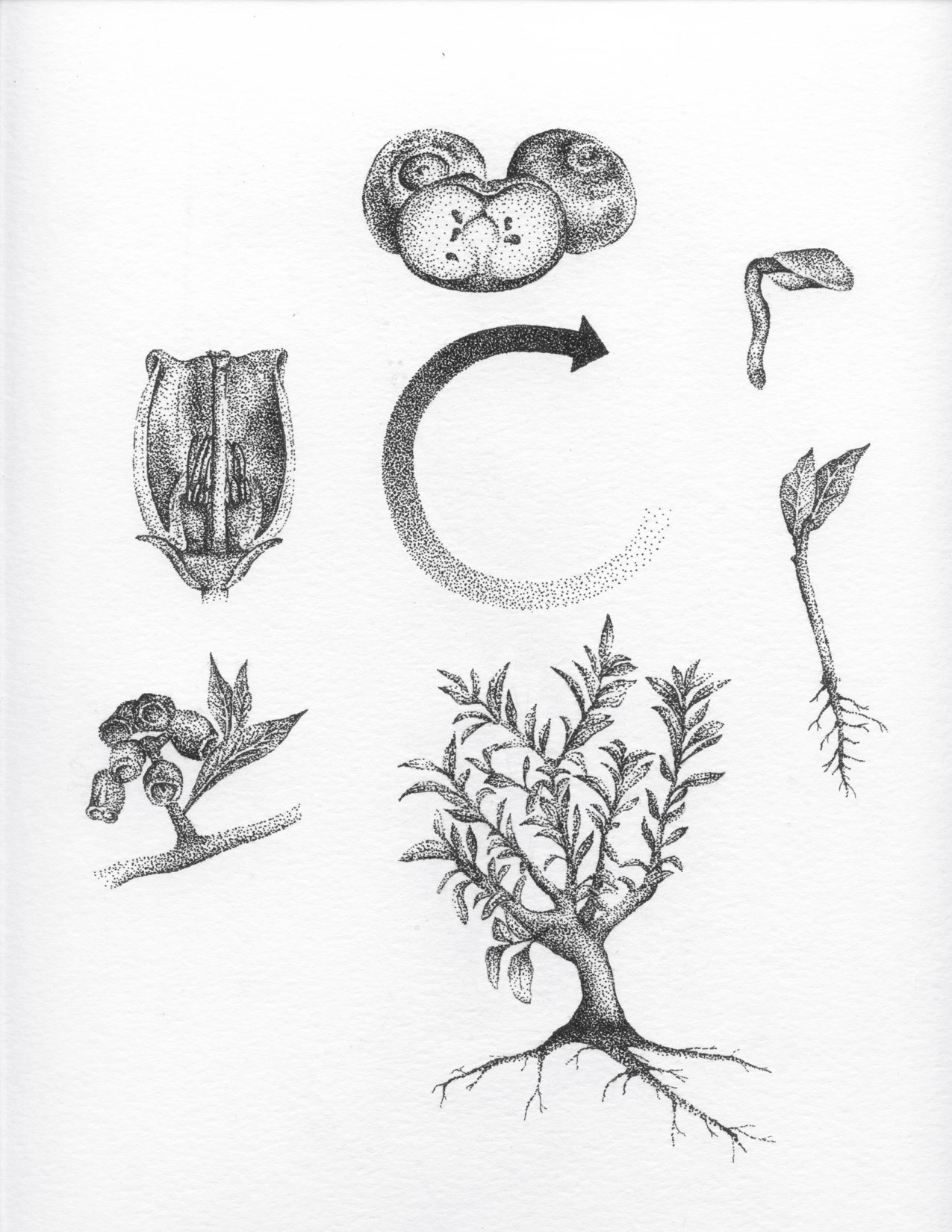 Mr. Zuppan created images to accompany a text written by Dr. Parker and Dr. Gilbert titled “The Evolutionary Ecology of Plant Disease”. Detailed life-cycle illustrations of the plant pathogens include both macroscopic and microscopic features and were selected based on attributes of the various life cycles. The illustrations show both key processes for the pathogen (sexual and asexual reproduction steps) and the disease (dissemination and survival), depicting structures and features of the pathogens in the context of the life cycle and natural history of the diseases.
Mr. Zuppan created images to accompany a text written by Dr. Parker and Dr. Gilbert titled “The Evolutionary Ecology of Plant Disease”. Detailed life-cycle illustrations of the plant pathogens include both macroscopic and microscopic features and were selected based on attributes of the various life cycles. The illustrations show both key processes for the pathogen (sexual and asexual reproduction steps) and the disease (dissemination and survival), depicting structures and features of the pathogens in the context of the life cycle and natural history of the diseases.
Enviro Envision
By Kathleen Deck (MFA Art 2019) and Alex Jones (Manager UC Campus Reserve)
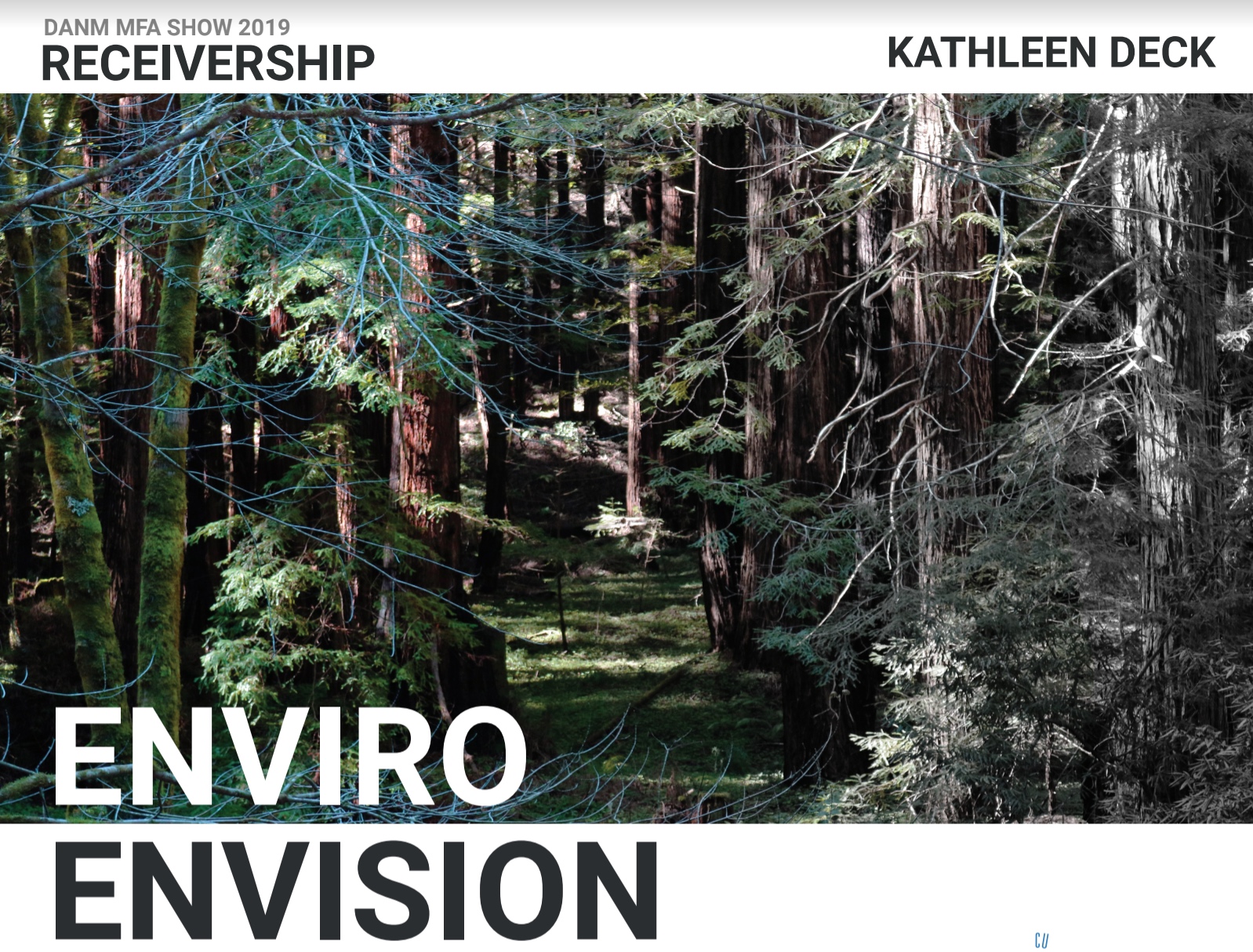 Using UCSC Natural Reserve data, research, and projected future scenarios, Ms. Deck created visually accurate paintings of the UC Santa Cruz upper campus reserve that can be navigated by the public. This interactive projection encourages a non-linear exploration of the narrative of a changing Santa Cruz Coastal Redwood ecosystem. By working with Mr. Jones she was able to depict research through audio recordings and visual imagery that share the complex interactions within an ecosystem and the effects of climate change on our local environments, thus enhancing public understanding.
Using UCSC Natural Reserve data, research, and projected future scenarios, Ms. Deck created visually accurate paintings of the UC Santa Cruz upper campus reserve that can be navigated by the public. This interactive projection encourages a non-linear exploration of the narrative of a changing Santa Cruz Coastal Redwood ecosystem. By working with Mr. Jones she was able to depict research through audio recordings and visual imagery that share the complex interactions within an ecosystem and the effects of climate change on our local environments, thus enhancing public understanding.
Illustrating Tropical Forest Restoration in Costa Rica
By: Karen Holl (Professor, Environmental Studies), and Michelle Pastor (Environmental Studies major)
 Professor Karen Holl and Doctoral Student Andy Kulikowski worked with Environmental Studies Undergraduate Michelle Pastor on science and illustrations related to their research on tropical forest restoration. Dr. Holl and colleagues have a now 15-yr long study of three different strategies to restore tropical forest replicated at 12 sites in southern Costa Rica. As the forest has developed in the experimental sites, it has become increasingly difficult to represent the changes in forest structure through photographs. For this residency, Ms. Pastor created three products: 1. a graphical pen-drawing abstract of vegetation recovery at the sites, which is posted online at the journal Applied Vegetation Science; 2. Three color drawings illustrating their restoration treatments after 15 years. 3. A pen and ink drawing of the insect-trophic cascade system of graduate student Andy Kulikowski. All these drawings are being used in talks and scientific papers.
Professor Karen Holl and Doctoral Student Andy Kulikowski worked with Environmental Studies Undergraduate Michelle Pastor on science and illustrations related to their research on tropical forest restoration. Dr. Holl and colleagues have a now 15-yr long study of three different strategies to restore tropical forest replicated at 12 sites in southern Costa Rica. As the forest has developed in the experimental sites, it has become increasingly difficult to represent the changes in forest structure through photographs. For this residency, Ms. Pastor created three products: 1. a graphical pen-drawing abstract of vegetation recovery at the sites, which is posted online at the journal Applied Vegetation Science; 2. Three color drawings illustrating their restoration treatments after 15 years. 3. A pen and ink drawing of the insect-trophic cascade system of graduate student Andy Kulikowski. All these drawings are being used in talks and scientific papers.
The residency helped the researchers to communicate a complex system to a general audience. Their restoration plots are shaded and are large enough that a single photograph doesn't illustrate all the characteristics of the system. The slightly stylized drawings allowed them to emphasize certain characteristics that would be difficult to see in the photo such as the straight lines of trees in their plantation restoration treatment vs. the much more heterogeneous trees in the natural recovery treatment. They could also illustrate a representative number and types of birds in the forest, which they’d never get in a single photo.
Joshua Tree Symbiosis in Stop-Motion Animation
By: Juniper Harrower (PhD, Environmental Studies), and Grace Ackles (Anthropology major)
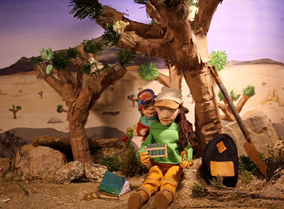
For this art/science collaboration, Dr. Harrower has translated her doctoral research into a narrative for stop motion animation. Joshua trees are under threat from climate change. Her ecological research focuses on how the plants are reproducing across Joshua Tree National Park, and whether the plants' key symbiotic interactions will be affected by the changing climate. Dr. Harrower and Ms. Ackles worked together to create a vision for the stop motion animation based on Ms. Harrower’s research. They created a highly detailed eight-minute animation that involved many other collaborators. This is currently being set to a musical score by noted cellist Erin Wang, and they will be submitting it to film festivals upon completion. They also created a second (much shorter and simpler) stop motion animation with a voice narrative to use as a descriptive example of Ms. Harrower’s research.
Dr. Harrower works as both an artist and a scientist (www.juniperharrower.com) but learned in this collaboration that the more time she spent explaining the science, the better Ms. Ackles could bring in her own ideas and perspective to the artwork. She learned that in giving Ms. Ackles some creative freedom with the project let to greater engagement and an overall better product quality.
Illustrating the Diverse Research at the Long Marine Lab
By: Betsy Steele (Research coordinator at UCSC Long Marine Lab) and Willow Mosely (Art major)
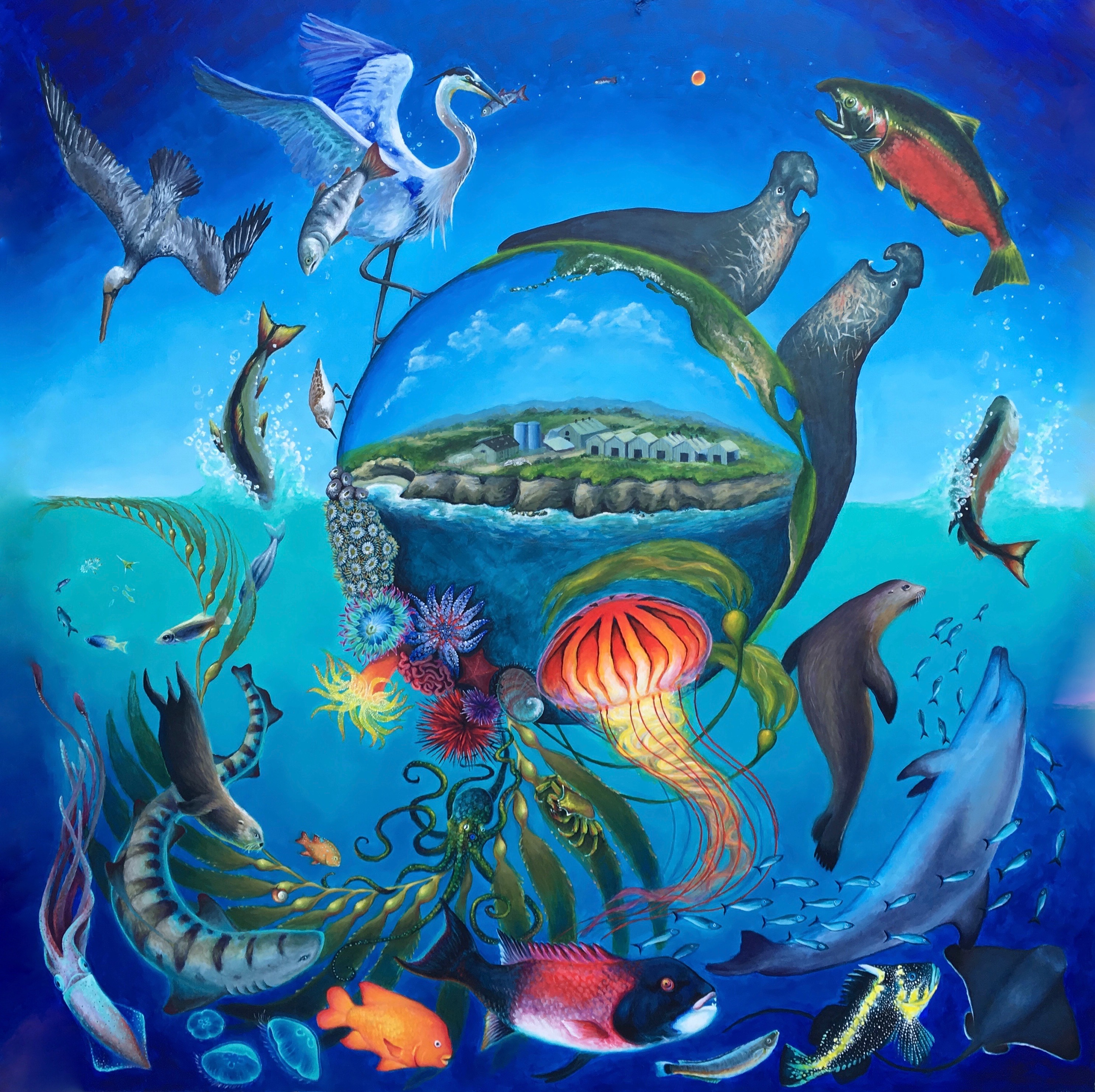 Long Marine Lab Research Coordinator, Betsy Steele, proposed an artistic and visual representation of the types of research performed at LML and in the field - with the hard work of Willow Moseley, it quickly became more than just an idea. Steele and Moseley had many in-depth conversations about the project and Moseley was highly receptive to the dynamic images and concepts asked of her. Together, they created a piece that not only reflects the diverse types of research at LML, but it is also a study in community ecology. The final artwork will be displayed in 3 different places on the Coastal Science Campus.
Long Marine Lab Research Coordinator, Betsy Steele, proposed an artistic and visual representation of the types of research performed at LML and in the field - with the hard work of Willow Moseley, it quickly became more than just an idea. Steele and Moseley had many in-depth conversations about the project and Moseley was highly receptive to the dynamic images and concepts asked of her. Together, they created a piece that not only reflects the diverse types of research at LML, but it is also a study in community ecology. The final artwork will be displayed in 3 different places on the Coastal Science Campus.
The Complex Life Cycles of Trout
By Ashley Ersepke (Ecology and Evolutionary Biology major) and Devon Pearse (Professor in Ecology and Evolutionary Biology, and NOAA research scientist)
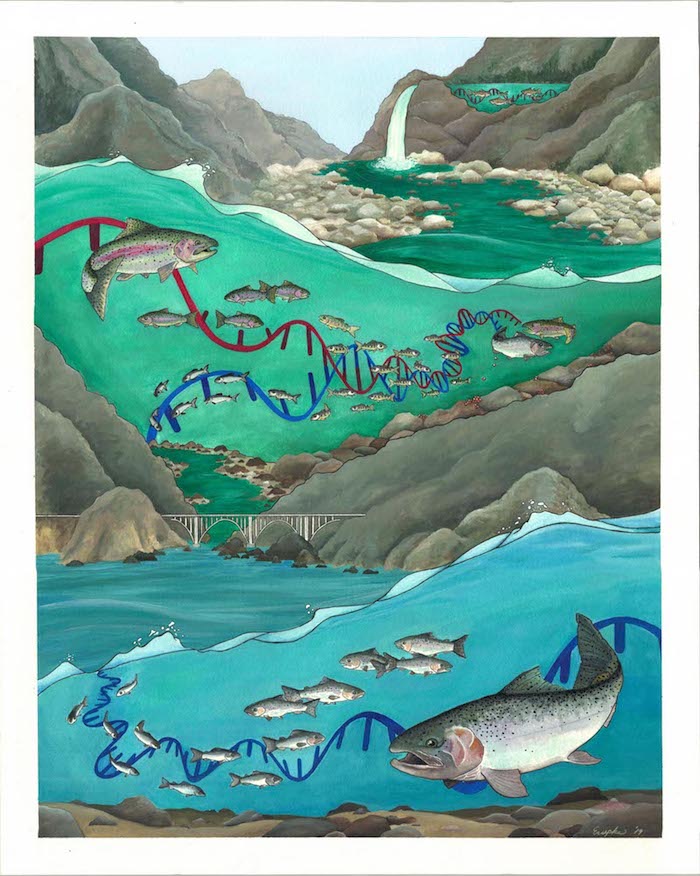 Working with Dr. Pearse, Ms. Ersepke created a striking and descriptive illustration depicting genetic and life cycle differences between Rainbow and Steelhead trout. In this species, some individuals live in freshwater their entire lives and are known as Rainbow Trout, while other individuals transform from juveniles into migratory 'smolts', swim to the ocean, grow, and then return to freshwater as adults to spawn. These individuals are known as steelhead and are listed as threatened and endangered in California. This illustration points to the genetic differences that Dr. Pearse and colleagues discovered which relate to the differences in life history and the developmental outcomes of the different types of fish.
Working with Dr. Pearse, Ms. Ersepke created a striking and descriptive illustration depicting genetic and life cycle differences between Rainbow and Steelhead trout. In this species, some individuals live in freshwater their entire lives and are known as Rainbow Trout, while other individuals transform from juveniles into migratory 'smolts', swim to the ocean, grow, and then return to freshwater as adults to spawn. These individuals are known as steelhead and are listed as threatened and endangered in California. This illustration points to the genetic differences that Dr. Pearse and colleagues discovered which relate to the differences in life history and the developmental outcomes of the different types of fish.
Sampling DNA in the Klondike
By: Trenton Kaufeldt-Lira (Art major) and Sabrina Shirazi (PhD candidate, Ecology and Evolutionary Biology)
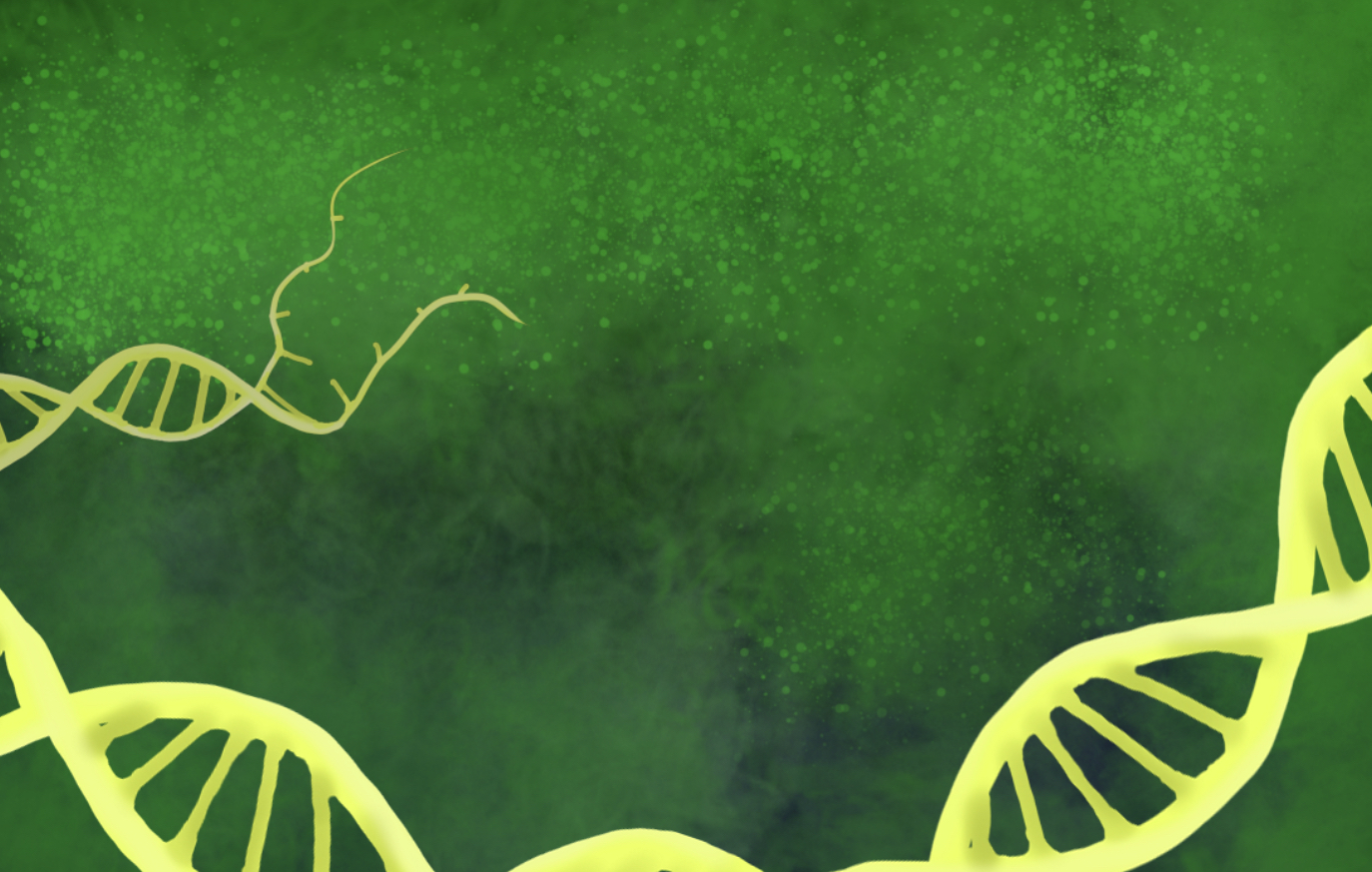 To explain several aspects of environmental DNA, Mr. Kaufeldt-Lira and Ms. Shirazi created a motion graphics animated video. The viewer follows a group of researchers who go to the Klondike territory of Canada to learn about the modern and ancient environment. The animated character sends a fictional drone into the ground that allows us to shrink down to the size of DNA and see where it is coming from, what it looks like, and what happens to it in soil. The drone utilizes ‘magnifying lenses’ (which in real practice are DNA primers) to identify what organisms the DNA originates from. This allows the viewer to see the abundance of DNA from different taxa in a system. The drone then travels further into the ground to investigate ancient environmental DNA, allowing an image of the past environment in the location they stand. The questions addressed through this animation are: What is environmental DNA? Where does it come from? What happens to it in soil? What happens to it through time? What can we learn from it? What are some tools that allow us to filter what we see?
To explain several aspects of environmental DNA, Mr. Kaufeldt-Lira and Ms. Shirazi created a motion graphics animated video. The viewer follows a group of researchers who go to the Klondike territory of Canada to learn about the modern and ancient environment. The animated character sends a fictional drone into the ground that allows us to shrink down to the size of DNA and see where it is coming from, what it looks like, and what happens to it in soil. The drone utilizes ‘magnifying lenses’ (which in real practice are DNA primers) to identify what organisms the DNA originates from. This allows the viewer to see the abundance of DNA from different taxa in a system. The drone then travels further into the ground to investigate ancient environmental DNA, allowing an image of the past environment in the location they stand. The questions addressed through this animation are: What is environmental DNA? Where does it come from? What happens to it in soil? What happens to it through time? What can we learn from it? What are some tools that allow us to filter what we see?
Thermal Imagery and Mammal Diversity in a Time of Changing Temperatures
By: Terri Williams (Professor, Ecology and Evolutionary Biology), and Sofia Vermeulen (Anthropology major)
 The goal of this collaboration is to engage students of all ages as well as the general public in the science of thermal diversity in terrestrial and aquatic mammals. Dr. Williams collected infrared thermal images of a wide range of animals at UC Santa Cruz and in collaborating zoological parks. These were used to create thermal profiles for each species. Ms. Vermeulen helped to create a science coloring book, award stickers, and a logo for Thermal Safari, an education program about the impacts of global warming for children and adults. Utilizing her bold images, she is working on a graphic for a book cover and scientific illustration regarding the impacts of noise on narwhals.
The goal of this collaboration is to engage students of all ages as well as the general public in the science of thermal diversity in terrestrial and aquatic mammals. Dr. Williams collected infrared thermal images of a wide range of animals at UC Santa Cruz and in collaborating zoological parks. These were used to create thermal profiles for each species. Ms. Vermeulen helped to create a science coloring book, award stickers, and a logo for Thermal Safari, an education program about the impacts of global warming for children and adults. Utilizing her bold images, she is working on a graphic for a book cover and scientific illustration regarding the impacts of noise on narwhals.
These images enable students and the public to quickly understand the scientific concepts that Dr.Williams is studying. She will be using them in teaching her physiology courses, in public lectures, books and in scientific articles.
Oral and Illustrated Histories for Micronesian Reef Conservation
By: Nicole Crane (Professor of Biology), and Charlotte Grenier (Environmental Studies and Art double major)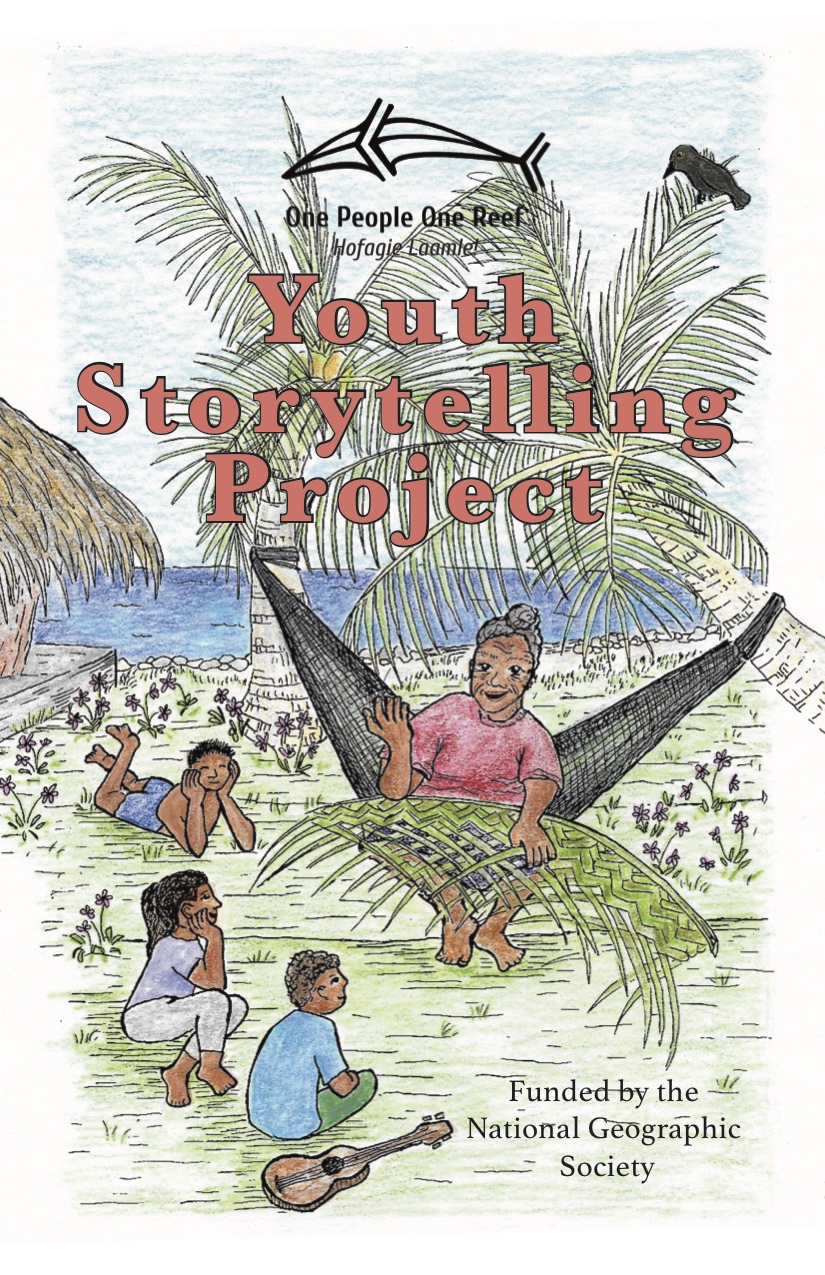 One People One Reef (OPOR) (onepeopleonereef.ucsc.edu) is a team of scientists from UCSC and other institutions, working together with Micronesian Outer Island community members since 2011, to advance adaptive management and conservation of coral reefs and associated resources. These autonomously governed communities are stewards for more than half a million square kilometers of ocean. They work closely with local communities to link traditional management and knowledge with modern science to better understand the nature of ecological and cultural change and their combined effect on resource management. Since these islands have strong oral storytelling traditions, they plan to develop this summary as an audio narrative, accompanied by an illustrated transcript. The narrative will be organized in several sections or ‘stories’ describing effective management practices applied over the past 7 years focusing on traditional management practices and the science that supports them. They will weave the science into the stories with data we have collected from local reefs, and empirical evidence from other studies.
One People One Reef (OPOR) (onepeopleonereef.ucsc.edu) is a team of scientists from UCSC and other institutions, working together with Micronesian Outer Island community members since 2011, to advance adaptive management and conservation of coral reefs and associated resources. These autonomously governed communities are stewards for more than half a million square kilometers of ocean. They work closely with local communities to link traditional management and knowledge with modern science to better understand the nature of ecological and cultural change and their combined effect on resource management. Since these islands have strong oral storytelling traditions, they plan to develop this summary as an audio narrative, accompanied by an illustrated transcript. The narrative will be organized in several sections or ‘stories’ describing effective management practices applied over the past 7 years focusing on traditional management practices and the science that supports them. They will weave the science into the stories with data we have collected from local reefs, and empirical evidence from other studies.
Charlotte also wrote a Norris Center Blog post about her time in Micronesia.
Almond Ecologies
By: Allyson Makuch (PhD Student Environmental Studies) and Emily Reisman (PhD candidate Environmental Studies)
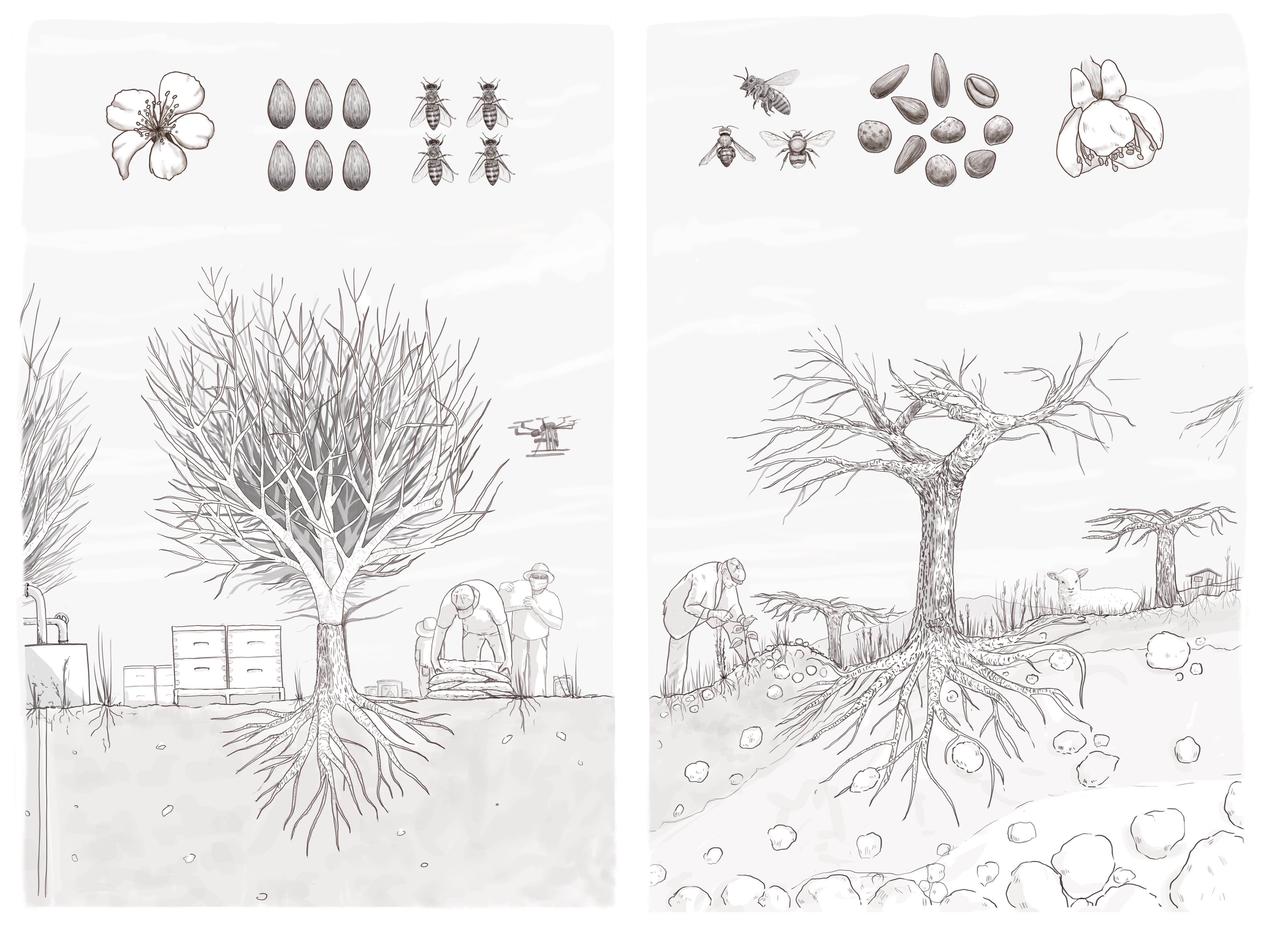 Ms. Reisman and Ms. Makuch collaborated to create a series of illustrations that represented the social and environmental relationships of almond agriculture that Ms. Reisman is tracing in her doctoral research. Some of the illustrations by Ms. Makuch represent diverse ways of “reading care” on the almond landscape. For example, in Spain it is not uncommon to see lichen benignly growing on almond trees; yet, many government officials see the lichen and “read” the lichen’s presence as carelessness. This particular reading of care has political consequences on the landscape. By illustrating some of the technological, agroecological, discursive, and biophysical relationships embedded in this system they are also hoping to disrupt traditional representations of the almond tree with the intention of making space for new conceptualizations of the organism.
Ms. Reisman and Ms. Makuch collaborated to create a series of illustrations that represented the social and environmental relationships of almond agriculture that Ms. Reisman is tracing in her doctoral research. Some of the illustrations by Ms. Makuch represent diverse ways of “reading care” on the almond landscape. For example, in Spain it is not uncommon to see lichen benignly growing on almond trees; yet, many government officials see the lichen and “read” the lichen’s presence as carelessness. This particular reading of care has political consequences on the landscape. By illustrating some of the technological, agroecological, discursive, and biophysical relationships embedded in this system they are also hoping to disrupt traditional representations of the almond tree with the intention of making space for new conceptualizations of the organism.
Natural History Illustrations and Global Environmental Change in Central Italy
By: Andrew Matthews (Professor, Anthropology) and Hannah Caisse (Ecology and Evolutionary Biology major)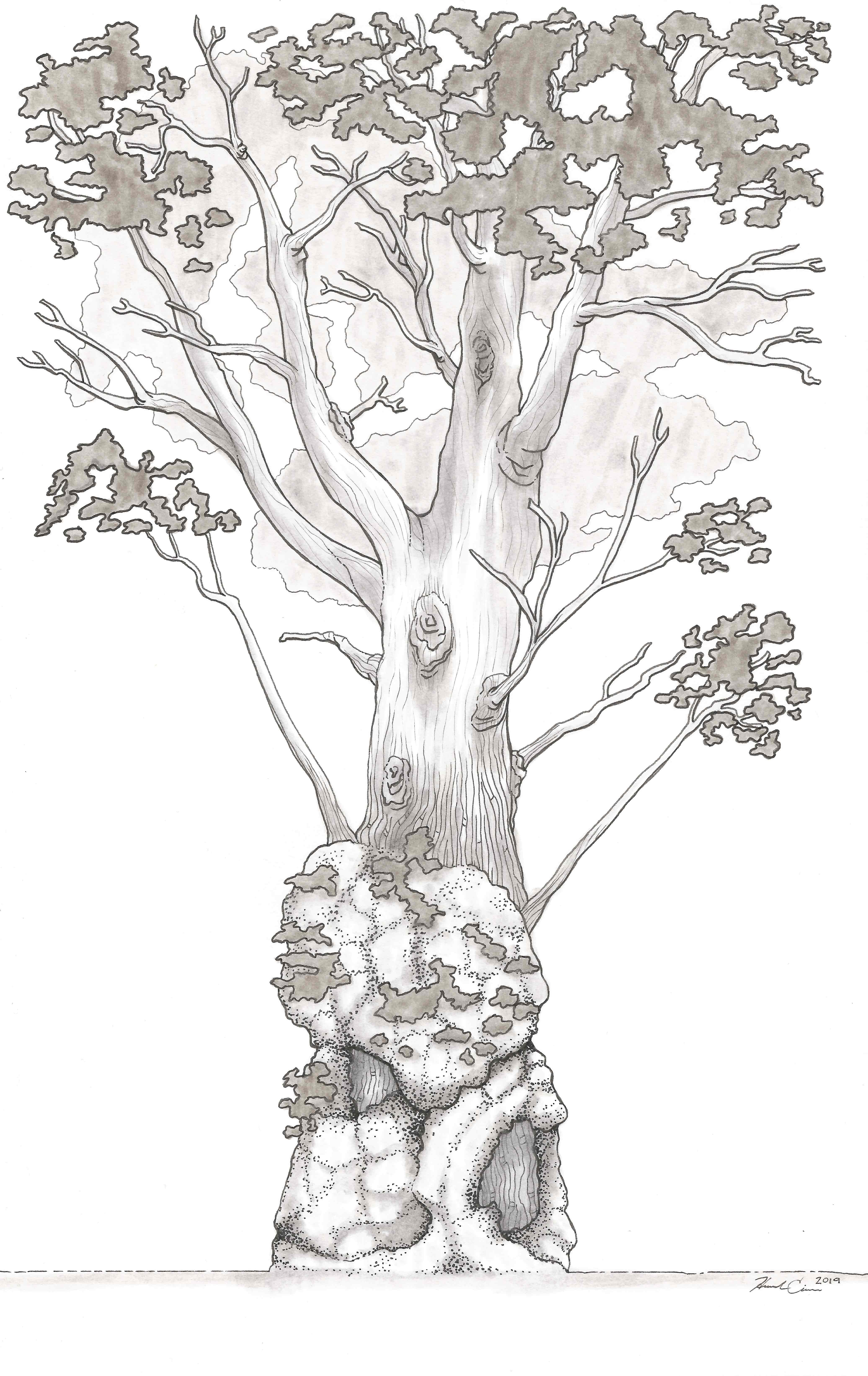 Illustrations by Ms. Caisse will be incorporated in a book that Dr. Matthews is writing about the intersection of history and anthropology, where he uses drawings as a source of evidence and theoretical arguments. This book, provisionally entitled Plant Politics, describes landscape history and the politics of forests, sustainable energy, and climate change in central Italy. In this book I argue that a re-imagined natural history and landscape ethnography that make extensive use of natural history illustrations can help us make sense of global environmental change.
Illustrations by Ms. Caisse will be incorporated in a book that Dr. Matthews is writing about the intersection of history and anthropology, where he uses drawings as a source of evidence and theoretical arguments. This book, provisionally entitled Plant Politics, describes landscape history and the politics of forests, sustainable energy, and climate change in central Italy. In this book I argue that a re-imagined natural history and landscape ethnography that make extensive use of natural history illustrations can help us make sense of global environmental change.
Whale Behavior Through a Photographer's Lens
By: Ari Freedlander (Professor, Ecology and Evolutionary Biology), and Andrew Baca (Environmental Studies major)
 Dr. Freedlander and Mr. Baca collaborated to create a set of images depicting different whales to communicate new findings on how whales thrive in a hostile ocean. Mr. Baca created realistic images of the whales that Dr. Freedlander is using to compare how the body plans of these whales change from species to species with differences in size. For example, is a minke whale that is relatively small, the same shape as a much larger blue whale? These products will be incorporated into a manuscript on scaling in feeding morphology of baleen whales.
Dr. Freedlander and Mr. Baca collaborated to create a set of images depicting different whales to communicate new findings on how whales thrive in a hostile ocean. Mr. Baca created realistic images of the whales that Dr. Freedlander is using to compare how the body plans of these whales change from species to species with differences in size. For example, is a minke whale that is relatively small, the same shape as a much larger blue whale? These products will be incorporated into a manuscript on scaling in feeding morphology of baleen whales.
Participating in the residency gave Dr. Freelander a new appreciation for how to communicate his science to non-scientists to come up with new outcomes and products.
